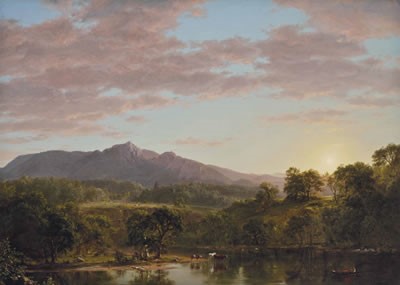Two things happened last month that served for me as contradictory bellwethers for the current state of the market for 19th century American art. The first was the annual meeting of the Appraisers Association of America. The second was the American auctions.
I should start by saying that the market for 19th century American art has never been a sexy one. In the 1980’s, when the Japanese were buying like drunken sailors, they were after French Impressionists and the School of Paris, not the artists of the Hudson River School.
Back then I used to laugh at the difference between the Impressionist and Modernist auctions and the ones for American art. The Impressionist and Modern sales were glamorous evening events with champagne being served, people in black tie air-kissing each other, and plenty of celebrity spotting – ooh, look, there’s Bianca Jagger!
“Stolid” was the adjective that came to mind for the American sales. The seats were filled with bankers from Toledo with their wives, while standing at the rear were us dealers, sipping tepid coffee from Styrofoam cups. The bid board showed the prices being bid in pounds, francs, yen, and so forth, just as it did during the Impressionist and Modern sales, but the conversion wasn’t necessary. American art traded only in dollars, as there wasn’t a worldwide demand.
After several ups and downs through the past 30 years, the Impressionist and Modern market today is doing fine. The players have changed – Chinese and Russian buyers are now major presences in the sales rooms. I don’t think there’s the sort of indiscriminate buying that was done when downtown Tokyo real estate was valued at a gazillion dollars per square inch, but any major work fresh to the market will meet or exceed its estimate, often setting a world record for the artist. The market for contemporary art at auction, while more volatile than the market for Impressionist and Modern, is also hot – dynamic, fashionable, collected by all the right people.
And American art – are we still the red-headed stepchild of the art market? To attend the annual meeting of the Appraisers Association of America, you might think so. I was listening to dealers and appraisers of 19th century furniture bemoan the American market. It’s true that a young person who has just gotten a promotion to Executive Vice President no longer feels the need to fill a house with what dealers call “brown furniture” to signal his or her arrival. Mid-20th-century Danish modern is much more desirable to young people. That American Hepplewhite sideboard that sold for $20,000 a quarter century ago now sells for a third of that price, and you’re lucky to get it. Even technology has conspired to batter the market – the armoires that used to be purchased to hide old-fashioned bulky televisions aren’t needed in this day of flat-screen TVs.
Until last week, I felt that way about 19th century American paintings as well. All the dealers are looking for collectors under the age of 65, I would complain to anyone who cared to ask. Yet at the American auctions last week, 19th century works did OK. They may not be fashionable among the jet set, but they’re still beautiful works of art, and I believe that beauty will always find a buyer. At Sotheby’s a 17 by 25-inch landscape of New England by Frederic Church, one of the leading lights of the Hudson River School, brought $852,500, including buyer’s premium. The estimate had been $600,000-$800,000.

That’s a fair amount less than the Church painting below, almost double the size of the one above, that Christie’s offered last May with an estimate of $3,500,000-$5,500,000. It failed to sell.

Part of the reason for the successful auction last week, compared to the earlier one, was that the auction houses had obviously worked with their sellers, encouraging them to have realistic expectations for the works they consigned. Would the Sotheby’s painting have sold for more money 20 years ago? Maybe. But $852,500 is still a nice chunk of change. I’ve always remembered something one of the old timers told me when I was starting out as a dealer: “Low prices don’t make a bad market – no buyers make a bad market.” The 19th century American market goes on. If it’s something you might be interested in, give me a call and let’s talk.

